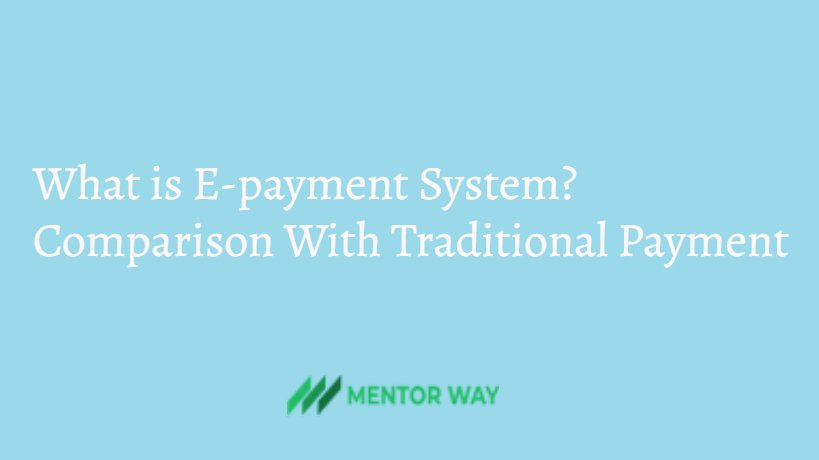What is E-payment System?Comparison With Traditional Payment
6 min read
In an e-commerce environment, payments take the form of money exchange in an electronic form and are therefore called electronic payments, Electronic payments (e-payment) are an integral part of e-commerce and are one of its most crucial aspects.
Electronic payment is a form of a financial exchanger that take place between the buyer and the seller facilitated by means of electronic communications. Electronic payment is a financial exchange that takes place in an online environment.
An electronic payment system is a system of financial exchange that is facilitated by a digital financial instrument such as encrypted credit card numbers, electronic cheques backed by a bank.
To a consumer, an electronic payment system is a convenient way of making a purchase or paying for a service without holding cash or having to go through the process of completing a cheque and producing some form of acceptable identification.
To a supplier of goods or services, and electronic payment is the receipt or outward movement of funds, linked into an inventory management, ordering or accounting system, eliminating the need of large cash holding, time-consuming clerical activities and offering easier management of cash flows.
To an account\ payment manager or bank, an electronic payment is a series of the process by which value exchange is captured, verified and accepted; a series of checks, balances to ensure integrity,
E-payment is based on electronic financial network, and communication technologies as a means to realize circulation and payment by making use of binary data stored in the bank computer systems. Thus an e-payment has following features:
- It is supported by computer technologies. It realizes storage, payment and circulation.
- Multiple functions are integrated together, including deposit, loan and non-cash settlement.
- It is widely applied to areas such as production, exchange, distribution and consumption.
- It us simple, secure, fast and reliable.
- It is usually accomplished through exclusive network for banks.
Electronic payment systems facilitate the most important action after the customer’s decision to pay for a product or service; which is the delivery of payments from customers to vendors in a most effective, efficient and problem-free way.
Various modes of electronic payment are:
- Electronic cash
- Electronic wallets
- Smart cards
- Credit cards
- Debit cards
- Charge cards
Characteristics of an electronic payment system:
Following are the essential characteristics of an electronic payment system:
-
Acceptability:-
The payment infrastructure should not only be robust, but also available and accessible to a wide range of consumers and sellers of goods and services. The value stored in the electronic cash should be honored and accepted by other banks and financial institutions for reconciliation.
-
Reliability:-
Users and businesses want a payment system that is reliable, because the availability of services and smooth running of an enterprise will depend on the availability and successful operation of the payment infrastructure. The users should be completely shielded infrastructures. The user should be completely shielded from a system or single point failure.
-
Security:-
Digital currency should be stored in a form that is resistant to replication, double-spending and tampering. At the same time, it should offer protection from the intruders trying to tap it to unauthorized use, when transmitted over internet.
-
Usability:-
The user of the payment mechanism should be able to use it as easily as real currency. This requires that the payment system should be well integrated with the existing applications and processes that acquire the role of transacting parties in e-commerce.
-
Scalability:-
The payment system infrastructure should be scalable, to be able to handle the addition of new users and merchants, so that systems will perform normally without performance degradation and maintain the quality of service. It should be able to offer the same performance and cost per transaction overheads with a growing number of customers and transactions.
-
Anonymity, privacy:-
This characteristic refers the desire of users to protect their privacy, identity and personal information. In some transactions, the identities of the parties could be protected by anonymising it. Anonymity means that it is not possible to discover someone’s identity or to monitor an individual’s spending patterns.
-
Applicability:-
Applicability of a payment system is defined as the extent to which it is accepted for payments at points of sale, or at online e-commerce sites. Debit cards and credit cards have high applicability, as one can pay with them in a variety of places. The applicability of a payment system may vary from country to country.
-
Authorization type:-
Authorization type is defined as the form of a control over the validity of transactions. The authorization type can be offline. Offline authorization means that users of the system can exchange money while not connected to a network, without a third party mediating the transaction. Paper cheques are an example of offline authorization.
-
Convertibility:-
Funds represented by one payment system should be easily convertible into funds represented by other payment systems. Users should be able to transfer money from electronic payment systems. Users should be able to transfer money from electronic payment systems to another accepted money from i.e. receive it in cash, or transfer to a bank account.
The electronic currency should be interoperable and exchangeable with other forms of electronic cash, paper currencies, and deposits in the bank accounts, bank notes or any other financial instrument.
-
Interoperability:-
A payment system in interoperable if it is not dependent on one company, but it is open and allows other interested parties to join. This can be achieved by means of open standards for data transmission protocols and infrastructure. An interoperable system can faster gain the necessary customer base for future development and will have a higher level of applicability.
-
Multi-Currency:-
Effective and efficient payment systems between countries are possible when a system allows processing multiple currencies, as it is currently done with credit cards. This feature is not implemented in payment systems of many countries, binding them to a particular region. Multi-currency payments are required for payments in cross-border e-commerce.
-
Traceability:-
Traceability indicates how easy it is to trace money flows and sources of funds that are going through a payment system and used for purchases. In electronic payment systems, money can be traced by records that are kept of payment activity.
-
Linkability:-
Linkability of an electronic payment system implies that payments can be associated with a particular user, or that it is possible to recognize several payments originating from some user. Users can be linked to their spending even if the system they use is anonymous. A relation between the user and his payments can be established.
14. Trust:-
Trust refers to the degree of customers confidence that their money and personal information will be safe, and that all parties involved will not act against users’ interests. Users need to trust that payments will be bot be stolen or misused.
-
Flexibility:-
Payment systems should be in a position to accept several forms of payment rather than limiting the users to a single form of currency.
-
Efficiency:-
Efficiency here refers mainly to the cost overheads involved in the operation of digital payments. The cost of payment per transaction should be negligible.
Comparison of Electronic Payment System with Traditional Payment System:-
Compared with tradition payment systems, e-payment has the following features:-
- E-payment introduces digital circulation to realize information transmission, so all means of e-payment are digitalized. But, traditional payment is realized through physical circulation such as cash circulation, bill transfer and bank exchange.
- The working environment of e-payment is based on an open system platform i.e. internet, while the traditional payment is operated in a relatively closed system.
- E-payment uses most advanced communication means, such as the internet and extranet. Whereas, traditional payment uses traditional communication media.
- E-payment has a very high requirement for both hardware and software facilities, generally including online terminals, relevant software and some other supporting facilities, while traditional payment does not have such a high requirement.
- E-payment enjoys advantages for it is convenient, fast, efficient and economic. As long as the user has a computer connecting to the internet, he will be able to stay indoors and complete the whole payment within a very short time. The cost is even less than one percent of that of the traditional way.



